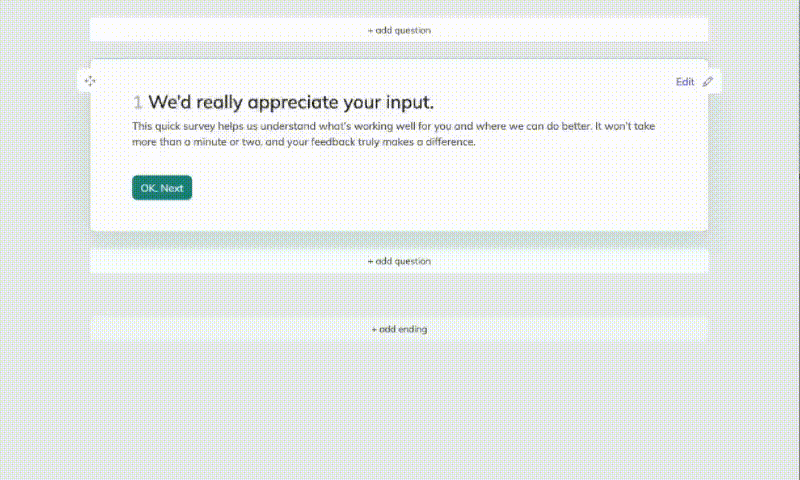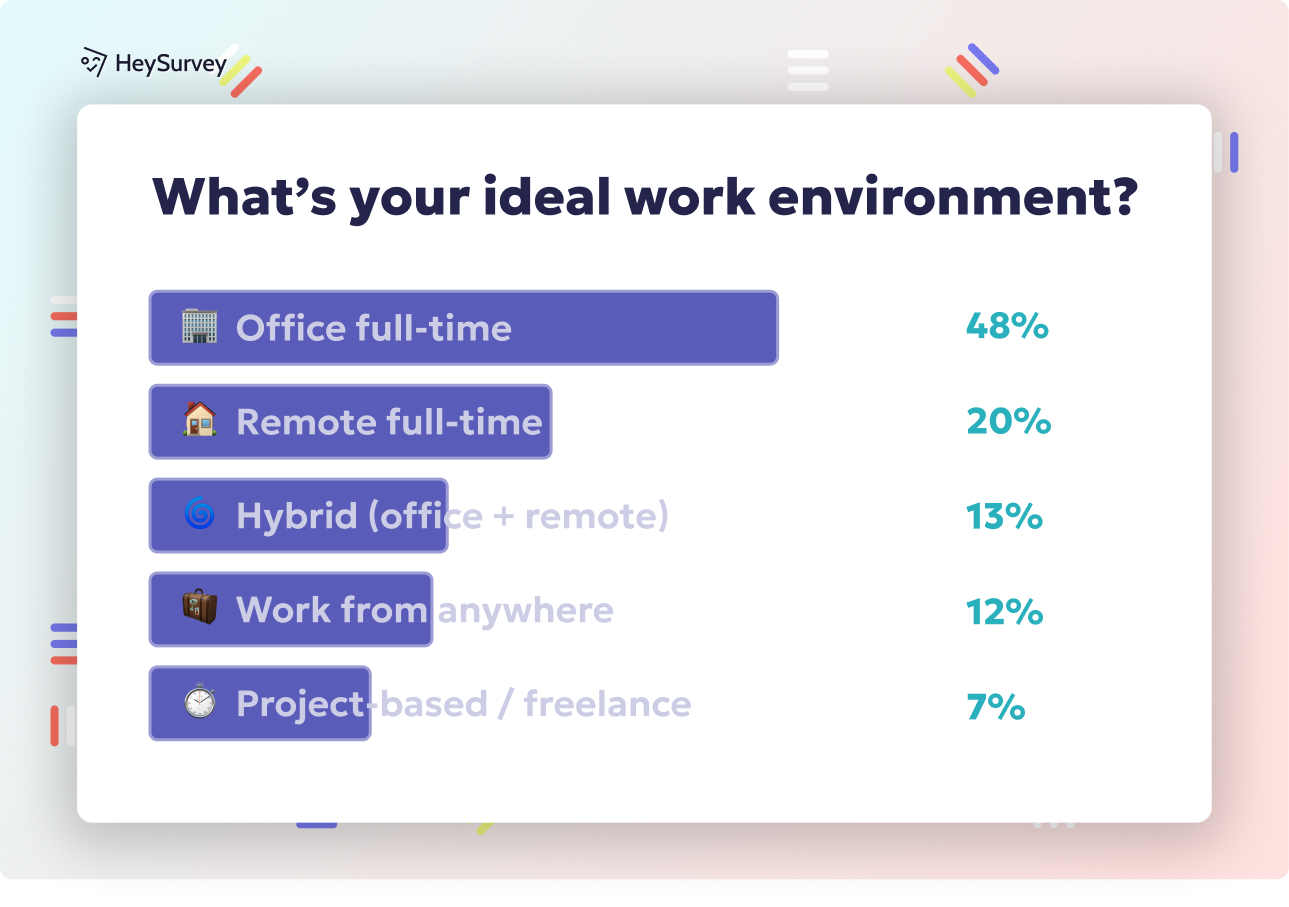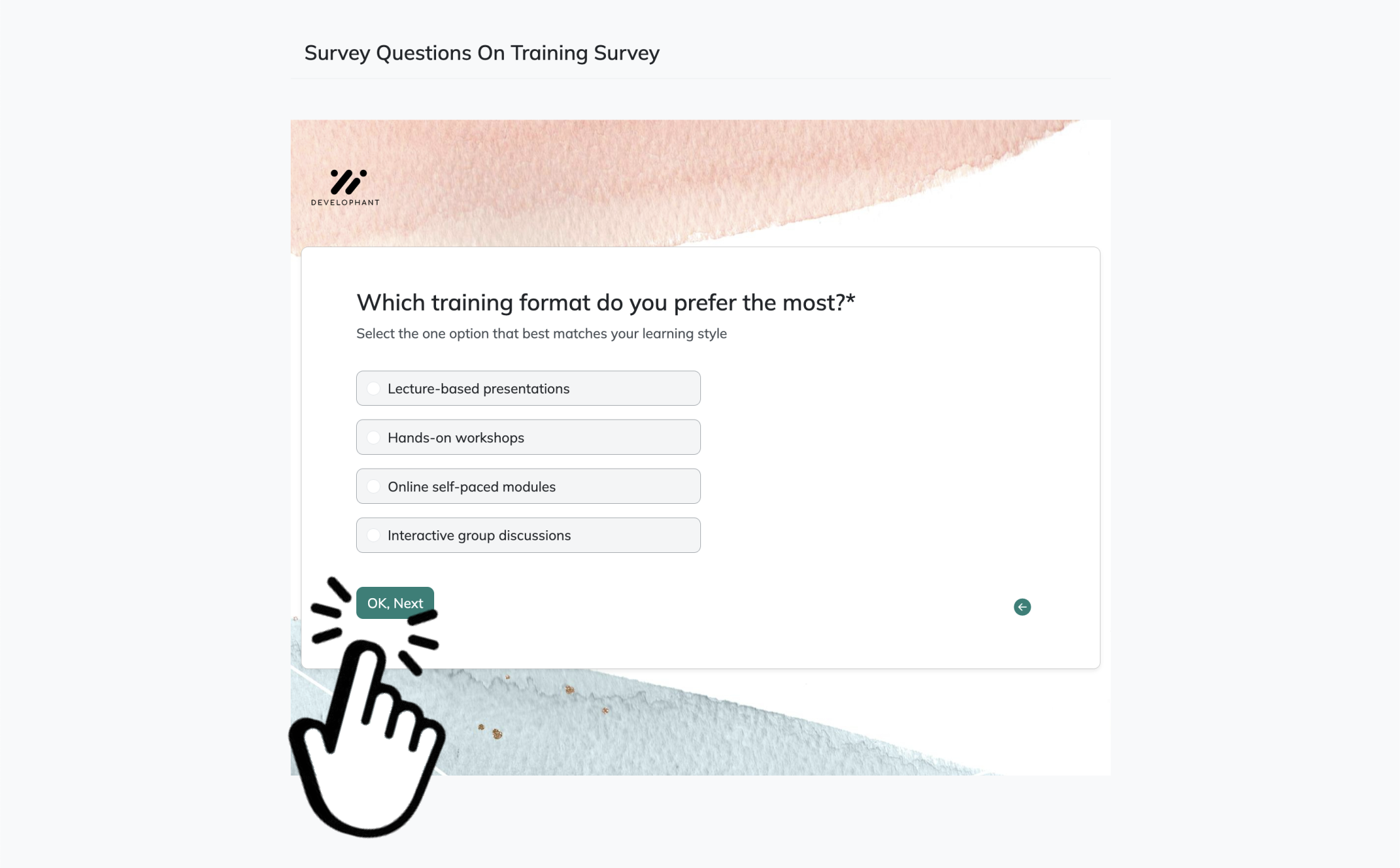30 Talent Acquisition Survey Questions to Improve Hiring
Discover 25 talent acquisition survey questions to enhance your hiring process, boost recruitment strategies, and gather candidate feedback.
Looking to turn your hiring funnel into a talent magnet? That’s where talent acquisition surveys come in. These nimble little questionnaires do more than cover HR bases. From candidate experience questions to the infamous recruitment evaluation survey, you’re not just collecting answers—you’re unlocking a smarter, faster, more lovable hiring experience. Imagine shorter time-to-hire, a shinier employer brand, and happier hiring managers at every twist and turn. You’ll want to be plugged in at all the right moments, like application, interview, and offer stages. Bonus: These post-acquisition survey questions and interview process feedback surveys can tune up your game instantly.
Candidate Experience Survey Questions
Why & When to Use
Every step a candidate takes in your process is a data goldmine—if you know how to dig. The candidate experience survey template isn’t just for show: it lets you gauge perceptions from the first click to the final handshake.
Plus, smart teams go live with their candidate experience questions 24 to 48 hours after each milestone, not just at the end. This timing is magic—it catches real feelings, not faded memories.
Here’s the thing: when you catch a candidate fresh from the interview or offer, you get honest feedback. Deploy these at
• Application complete
• Interview finished
• Offer extended
• Overall wrap-up
Short, clear, and delivered right after each stage is how you win the authenticity game.
5 Sample Questions
You want actionable feedback, not a rambling story. Try these candidate experience survey questions for a start:
How easy was our application portal to navigate?
Did recruiters communicate timelines clearly?
Rate the relevance of interview questions to the role.
How respected did you feel throughout the process?
Would you recommend applying here to a friend?
Tune Your Candidate Experience Survey Template
A good candidate experience survey template does more than check boxes—it adds clarity and trust around your brand. Mix up questions to touch on usability, recruiter communication, and candidate comfort.
Don’t be afraid to sprinkle in a quick satisfaction rating or Net Promoter Score for trend spotting.
• Use simple, mobile-friendly formats
• Keep surveys snappy—think <5 minutes
• Always thank candidates for helping you improve
The secret ingredient? Actually closing the loop—show you really heard them.
Sending candidate experience surveys 48–96 hours after communicating a hiring decision yields more balanced feedback by allowing candidates to process outcomes yet still recall specifics. Source

Certainly! Here are easy step-by-step instructions for creating your own survey with HeySurvey, specifically tailored for new users. After these steps, you can open a relevant template and start right away using the button below the instructions.
How to Create a Survey in HeySurvey: 3 Simple Steps
Step 1: Create a New Survey
- Click the “Use This Template” Button Below
This instantly loads a ready-made template suited to your needs. If you want to start from scratch or explore other templates, you can do so from the dashboard. - (Optional) Give your survey a name
You can edit the internal title at the top of the Survey Editor for easy management.
Step 2: Add Your Questions
- Click “Add Question” to insert new questions.
- Choose a question type (e.g., text, choice, scale) from the menu.
- Type your question and possible answers, add images if desired, and set whether the question is required.
- Duplicate or reorder questions as needed.
Step 3: Publish Your Survey
- Preview your survey by clicking the “Preview” button to see how it will look for respondents.
- Publish your survey to get a shareable link (note: you’ll need to create a free HeySurvey account if you haven’t already).
- Share the link with your audience or embed the survey on your website.
Bonus: Personalize and Optimize Your Survey
Apply Your Branding:
Upload your logo, change colors or fonts, and adjust the background using the Designer Sidebar for a professional touch.Define Survey Settings:
Set start/end dates, response limits, completion redirects, and choose whether respondents can view results.Add Branching or Skip Logic:
For surveys with multiple pathways, use the branching options to show or skip questions based on previous answers, ensuring a personalized flow for each respondent.
Ready to Start?
Click the “Use This Template” button below to launch the template and begin customizing your survey!
For more details or feature explanations, refer to the comprehensive How HeySurvey Works guide above.
Interview Process Feedback Survey Questions
Why & When to Use
Think of interview process feedback survey questions as your power tool for in-the-moment insight. Run these within 24 hours of the interview to capture feedback before it fades.
Why bother? You catch reflections while they're fresh, which means you get the real story. Plus, sending a quick feedback link after every interview keeps candidates and interviewers feeling valued.
On top of that, regular feedback lets you dial in things like structure, timing, and interviewer style. If words like "awkward" or "rushed" pop up, you’ll know where to adjust.
5 Sample Questions
Here are five punchy questions to stir some honest feedback:
How well did the interviewer explain the role’s responsibilities?
Were the interview logistics (location, video link) convenient?
Did the interview duration feel appropriate?
Which interview stage added the most value?
What would have improved your interview experience?
Power Up Your Interviews
Regular interview process feedback surveys help you refine your approach and delight your candidates. Plus, patterns in the feedback highlight what’s working—or what’s driving people nuts.
Try randomizing the order sometimes to fight survey predictability.
• Make sure each question feels personal
• Give context: “We love honest feedback—help us get better!”
• Rotate qualitative and quantitative questions for balance
What works? Getting actionable, stage-specific comments every time.
Asking candidates for survey feedback within nine days post-interview yields 94% of responses, maximizing timely insights into the interview experience [Ashby] source
Recruitment Evaluation Survey Questions
Why & When to Use
A quarterly recruitment evaluation survey is your report card for the end-to-end funnel. These surveys spotlight what’s humming along and what’s overdue for a tune-up.
High-performing teams use them to align HR with business outcomes, not just surface stats like time-to-hire. If you want to keep improving, measure often and share results.
Plus, these surveys connect the dots from candidate survey questions to pipeline performance, diversity, cost, and channel effectiveness.
5 Sample Questions
Solid recruitment evaluation survey items for quarterly review:
Rate the average time between application and first contact.
How satisfied are you with the diversity of shortlisted candidates?
Did assessment tools predict on-the-job performance accurately?
How cost-effective was the last hiring campaign?
Which sourcing channel produced the highest-quality talent?
Bringing Your Recruitment Evaluation Survey to Life
You don’t need a fancy dashboard to start—though it helps! What matters is tracking trends, surfacing quick wins, and highlighting chronic bottlenecks.
Dig into response rates by channel to find your superstar sources. And remember:
• Set benchmarks so you can celebrate real progress
• Share findings with both TA and leadership (transparency wins trust)
• Let the data lead you to smarter bets next quarter
Your recruitment evaluation survey is like choosing the right playlist: when you get it right, everything runs smoother.
Hiring Manager Satisfaction Survey Questions
Why & When to Use
Let’s shine a light on hiring manager satisfaction survey questions. These gems find out if your talent acquisition promises lived up to the hype—for internal clients, too.
Sending this survey after a role closes is sure-fire—managers are still “in the zone,” so you’ll catch details before they vanish. Plus, it shows you treat them as partners, not obstacles.
Here’s the thing: the fastest way to improve relationships between recruiters and hiring managers is to ask the right questions at the right time.
5 Sample Questions
Aim these hiring manager satisfaction survey questions at your most critical stakeholders:
How closely did the candidates meet your job requirements?
Rate communication with your assigned recruiter.
Were role profiles/job adverts accurate?
How satisfied are you with time-to-fill?
What can TA improve for your next hire?
Why These Questions Pack a Punch
Think of this survey as a partnership builder—better questions uncover what teams truly value. Plus, it’s a feedback cycle that fuels faster, friendlier hires next go-round.
Keep the tone friendly and feedback actionable:
• “What could we do differently?” shows openness
• Offer text boxes for nuance—you’ll get gold
• Always share outcomes from past survey input
Doing this regularly turns “HR says so” into “look what we built together.”
Timely, specific hiring manager feedback reduces time-to-hire by approximately 2.5 days, improves source-to-hire ratios by ~15%, and boosts quality-of-hire by ~20% (blog.truegeometry.com)
New Hire Onboarding / Post-Acquisition Survey Questions
Why & When to Use
These post-acquisition survey questions roll out at 30, 60, or 90 days—right after your shiny new hires settle in. You want the truth: did reality match the sales pitch?
If you start your acquisition survey early, you catch pain points before they snowball and send top talent running. Plus, these checks aren’t just HR box-ticking—they kick off retention momentum.
Onboarding surveys also tie in with candidate experience survey questions: the journey doesn’t end with “Welcome aboard.”
5 Sample Questions
Here’s a focused batch for your next onboarding survey:
Did the onboarding plan prepare you for your role?
How welcoming was your team on day one?
Were relocation or benefits details handled smoothly?
Do you feel aligned with company culture and values?
What was the biggest onboarding gap you noticed?
Why Onboarding Feedback Matters
Early post-acquisition survey questions serve as insurance for your talent brand. You’re not just checking facts—you’re proving your EVP delivers as promised.
Keeping it fresh means:
• Mixing in open-ended prompts to spot unique insights
• Spacing the surveys for real trends, not kneejerk reactions
• Sharing results with people leaders so nothing falls through the cracks
Plus, “HeySurvey is free, forever”—so there’s no excuse to skip these touchpoints.
Employer Brand & Talent Attraction Survey Questions
Why & When to Use
Ever wonder why people flock to your brand (or sprint away)? Talent attraction survey questions reveal the real story behind your talent magnetism.
These quick pulses—run annually or even quarterly—unlock priceless intel on what draws in top candidates (and what scares them off).
Knowing this lets you tune your EVP, messaging, and job marketing campaigns for max magnetism.
5 Sample Questions
Try these for your next talent attraction checkup:
How did you first hear about our company?
Which of our brand messages resonated most?
What nearly stopped you from applying?
How would you describe our employer brand in three words?
Which competitors did you consider and why?
Get Granular with Talent Brand Insights
A consistently-run employer brand survey is a goldmine for authentic, trend-driven storytelling. The secret? Translate candidate survey questions into actionable talent marketing strategy.
Mix up channels—email, LinkedIn, post-apply nudges—to hear from every segment.
• Ask rejected candidates, too—they have unique insight!
• Make branding feedback anonymous to pull out real stories
• Use visuals and quotes to refresh your careers page
Plus, this input arms you for EVP refreshes and talent community building.
Rejected Candidate Feedback Survey Questions
Why & When to Use
A gentle rejected candidate feedback survey is your best tool for protecting your employer brand after the “no.” Sent within a week, it’s both polite and proactive at surfacing process weaknesses.
This isn’t just about ego-soothing—it’s about taking care of future applicants and keeping the feedback flowing both directions.
Here’s the thing: candidates love a good process, even if the outcome wasn’t in their favor.
5 Sample Questions
Turn the page from rejection to relationship-building with these:
Was rejection feedback clear and constructive?
How fair did the selection criteria feel?
Would you re-apply for future roles here?
What stood out as the weakest part of our process?
How likely are you to speak positively about us despite the outcome?
Keeping Doors Open for Future Talent
Offering a candidate survey post-rejection shows class and confidence. Plus, it helps you spot where candidate experience questions reveal dealbreakers.
Keep it simple:
• A short, mobile-friendly survey goes a long way
• Thank candidates even more sincerely—they might be future fans or hires
• Nudge for honest, constructive comments—avoid the “just rate us” trap
And hey, every strong survey reply is a chance to build goodwill.
Best Practices: Dos and Don’ts for Talent Acquisition Surveys
Dos
Nail your talent acquisition survey game by making each interaction feel smooth and personal. Here’s how you can drive high response and authentic feedback:
• Keep surveys under five minutes—it shows respect
• Personalize each invitation with the candidate’s name and stage
• Use logic branching for tailored, relevant questions
• Optimize for mobile, every time
• Close the feedback loop by sharing what you learned (and how you acted)
Plus, leveraging great survey tools multiplies your insight without multiplying your workload. “HeySurvey is free, forever,”—you can use all the premium features, no sneaky fees.
Don’ts
Avoid these classic stumbles that tank response rates and burn bridges:
• Don’t write leading or “gotcha” questions—neutral phrasing wins
• Never ask for identifying info if you promise anonymity
• Don’t spam the same candidates—spread out your surveys to prevent fatigue
• Skip overly repetitive questions that add no value
• Don’t let response data gather dust—share and act quickly
Plus, respect data privacy and format for fast, clear feedback so candidates come back, not drop off.
Power Features & Tips
Modern tools have neat features you can—and should—use. Branching logic routes folks to the right questions, while instant mobile optimization ensures everyone can reply via their thumbs. Data dashboards? They don’t just look pretty—they let you quickly spot patterns in hiring manager survey questions and act in real time.
• Turn recurring survey replies into action plans
• Visualize trends for leadership in snappy charts
• Use notifications to remind hiring managers and TA teams to review results
Keep surveys smart, snappy, and feedback-fueled.
Successful talent acquisition surveys fuel teamwork and turbocharge your hiring process. By surveying at every touchpoint and listening closely, you nurture candidate trust, hiring manager confidence, and process transparency. Customize your templates, experiment with A/B testing, and sync survey data right into your ATS or HRIS. Don’t wait—grab your free candidate experience survey template and start learning what your talent really thinks. Or, sign up for our newsletter for game-changing tips—no elevator pitch, just better hiring.
Related Hiring Survey Surveys

25 Quality of Hire Survey Questions to Measure New-Hire Success
Discover 30 expert quality of hire survey questions across 6 surveys to accurately measure new-hi...

29 Hiring Manager Satisfaction Survey Questions to Boost Hiring
Discover 25 hiring manager satisfaction survey questions with expert tips to improve recruiter al...
